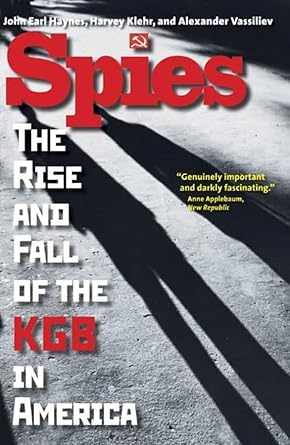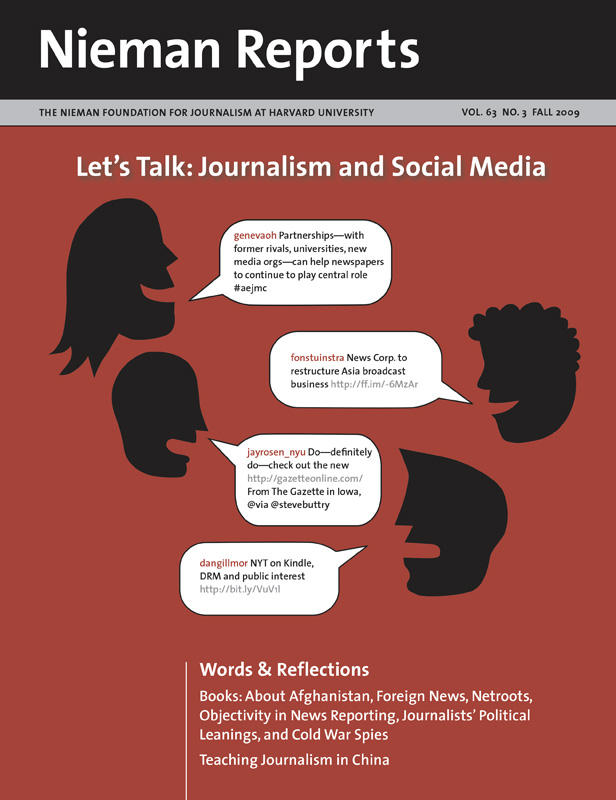
John Earl Haynes, Harvey Klehr, and Alexander Vassiliev
Yale University Press. 704 Pages.
Spies and journalists, journalists and spies: Is there a difference? Tightly embraced, the two disciplines historically played off each other in the search for foreign news and information.
Sometimes there were no degrees of separation. U.S. agencies used journalists as covert agents until the reforms of the Vietnam era. As a Congressional committee reported in the early 1970’s, “Full-time correspondents for major U.S. publications have worked concurrently for the CIA, passing along information received in the normal course of their regular jobs and even, on occasion, traveling to otherwise non-newsworthy areas to acquire data.”
The agency also had stringers and other freelancers who collected information and rumors and planted stories in foreign media that were fed into the international news traffic and sometimes appeared in U.S. print and electronic outlets.
Of course, the rationale was, “everyone does it.” The British certainly did. Kim Philby, the most notorious double agent in modern times, was placed in Beirut by British intelligence as correspondent for three icons of the London media, The Times, The Economist, and The Observer. He ran to Moscow with the wife of an American colleague after London finally discovered his higher allegiance.
Still, the grand champions at mixing the two trades were the Russians with their ubiquitous KGB and GRU, the military intelligence arm. In this new, encyclopedic book about Soviet spies, one of the authors, Alexander Vassiliev describes how he was recruited for the American division of the KGB.
He was “clean,” meaning no Jews in his family; he had high grades and good language skills, and he was politically loyal and sober. “Plus, I was going to get a degree in international journalism, and that profession was considered the best cover for an intelligence officer.”
After a year of honest presswork to assume his disguise, Vassiliev went to work for the KGB until the agency was shut down by the collapse of the Soviet Union. By chance, the post-Soviet security agency assigned Vassiliev to collect information from secret files on espionage for publication in the United States. These files provide the core of “Spies: The Rise and Fall of the KGB in America.”
This book is a thorough documentation of the recruitment and operation of Moscow’s spy networks. It follows three previous essential books also produced by John Earl Haynes, a historian at the Library of Congress, and Harvey Klehr, a professor at Emory University: “Venona: Decoding Soviet Espionage in America,”“The Secret World of American Communism,” and “The Soviet World of American Communism.”
“Spies” has received greatest attention for closing the cases of Alger Hiss and Julius and Ethel Rosenberg as genuine Soviet agents and clearing any remaining doubts about Robert Oppenheimer, who was not a spy.
No, this is not a rerun of the McCarthy hearings. These are nonpolitical case studies that produce clear verdicts of individual culpability. And the authors do not pretend to have exhausted the subject. The notes that Vassiliev collected are not complete. His access was cut off after the reform government was replaced and former Communists took charge of the SVR, the successor to the KGB.
The new material has made it possible for the authors to close the headline cases, delve deeper into the entire range of Soviet espionage, and devote a chapter to spies and journalists. One conclusion they reach is that everyone’s favorite leftist journalist, I.F. Stone, was a paid Soviet agent in 1936-38 and that he kept close contact with Soviet intelligence for at least six more years.
The authors discuss the disagreement among those who believe Stone was only a Soviet sympathizer and those who think he was an active Soviet agent. The use of a specific Russian phrase in his files is what led Haynes and Klehr to conclude that Stone was paid to spy for the Soviets. The file states that Stone entered “the channel of normal operational work” in 1936. This term was reserved for paid agents. (Others who’ve written about “Spies,” such as Nicholas Lemann, are not persuaded; he wrote in his New Yorker review that the authors were not able to “establish that Stone was paid or had more than occasional contact with the KGB.”)
Under his birth name, Isidor Feinstein, Stone was given the undercover name “bliny” or pancake and asked to supply tidbits of information and to recruit or identify other possible agents or informants. The authors claim that he acted as the intermediary between at least one recruit and the KGB.
His name disappeared from the files after 1938, presumably because, like many American leftists, Stone resented the notorious 1939 pact between Stalin and Hitler. Now known under his new byline, I.F. Stone was again in contact with KGB sources in 1942 and, in 1943, he employed the wife of Stanley Graze, a KGB source, as his personal secretary. In 1944, a well-known KGB agent, Vladimir Plavdin, tried to re-enlist Stone, but was rebuffed because Stone, the father of three children, feared he would be identified by the FBI.
Dan Froomkin reviewed MacPherson's book in the Summer 2007 issue of Nieman Reports.Still, dear old “Izzy” has outspoken defenders. Myra MacPherson, a skilled journalist who wrote the 2006 book, “All Governments Lie: The Life and Times of Rebel Journalist I.F. Stone,” published a blog post in May for The Huffington Post that admitted Stone was myopic about Russia, “But being misled and naive does not make one a spy.”
Stone had been recruited by Frank Palmer, a labor journalist and KGB agent who ran Federated Press, a leftist news agency that supplied material to union newspapers and radical publications in the 1930’s. Palmer also signed up Louis Budenz, who became managing editor of the Communist Party paper, the Daily Worker, and later reappeared as a rabid anti-Communist.
The KGB in 1941 counted 22 journalists among its American agents, plus 49 engineers, four economists, and eight professors. While Moscow had a priority for technical information, it recruited journalists “for their access to inside information and sources on politics and policy, insights into personalities, and confidential and nonpublic information that never made it into published stories.”
Dozens of other American journalists met regularly with Russians who identified themselves as journalists but were KGB or GRU officers. Only Soviet citizens with the highest security clearance could meet openly with foreigners. The Americans thought they were getting inside information from these contacts, but the Russians peddled dross. The gossip Americans offered had higher value to the Kremlin and sometimes earned them cover names for the files.
Ernest Hemingway had enough contacts to be given a KGB code name, “Argo,” but he was written off after he attacked the Soviet Union in print. The KGB was fascinated by the well-connected columnist, Walter Lippmann, a liberal whose position in journalism has never been replicated. The KGB called him “Imperialist,” but only penetrated his office by planting Mary Price, a Communist, as his secretary.
Pravdin, the agent who failed to re-enlist Stone or seduce Lippmann, was ostensibly a TASS correspondent, but actually was number two in the New York KGB station. He was the complete KGB agent; in 1944, in Switzerland, he assassinated Ignace Poretsky, a KGB defector.
Whittaker Chambers, a GRU agent who was later a highly respected writer for Time, and Helen Bentley, operator of a KGB network, reported for PM, a short-lived New York tabloid that employed many leftists. She recruited Bernard Redmont, one of the best-known reporters named in this book, who was called “Berny” in the Communist Party and “Mon” in the KGB files.
Redmont supplied marginal material to his handlers until he was cut off in 1945. He always denied his Communist connections through a long career with U.S. News & World Report, CBS and Westinghouse Broadcasting, and Boston University.
Among other names identified in “Spies,” Winston Burdett was called “Eagle” by the KGB, since he was a foreign correspondent for the former Brooklyn Eagle, who contacted foreign agents in his European travels. George Seldes reported from Moscow for the Chicago Tribune and later joined the Communist Party and published a left-wing newsletter with Bruce Minton, a KGB contact. Robert Allen, best known as Drew Pearson’s partner in the hard-hitting column Washington Merry-Go-Round, was paid $100 a month by the KGB early in his career.
The journalist chapter is only a small part of this massive study that melds together the new material with the research from the authors’ three previous books. Many of the journalists here were marginal to the trade, but there are enough of them to affirm the conclusion the authors reach:
Unlike government employees or scientists who broke the law by turning over classified material to the KGB, most of the journalists profiled … violated no statute of that era. Few had any access to secret data. Members of a profession dedicated to openness, however, they covertly enlisted in an organization dedicated to deception.
They used their access to information to deceive their employers, their colleagues, and their publics about their loyalties and veracity. They betrayed confidences and pursued political agendas while pretending to be professional journalists.
Citing Stone, the authors pointed out that some reporters “wrote prolifically about issues of subversion and espionage without ever acknowledging that they knew far more about how the KGB operated than they cared to express.”
Murray Seeger, a 1962 Nieman Fellow, covered the former Soviet Union, Eastern and Central Europe for 10 years for the Los Angeles Times. He is the author of “Discovering Russia: 200 Years of American Journalism.”



